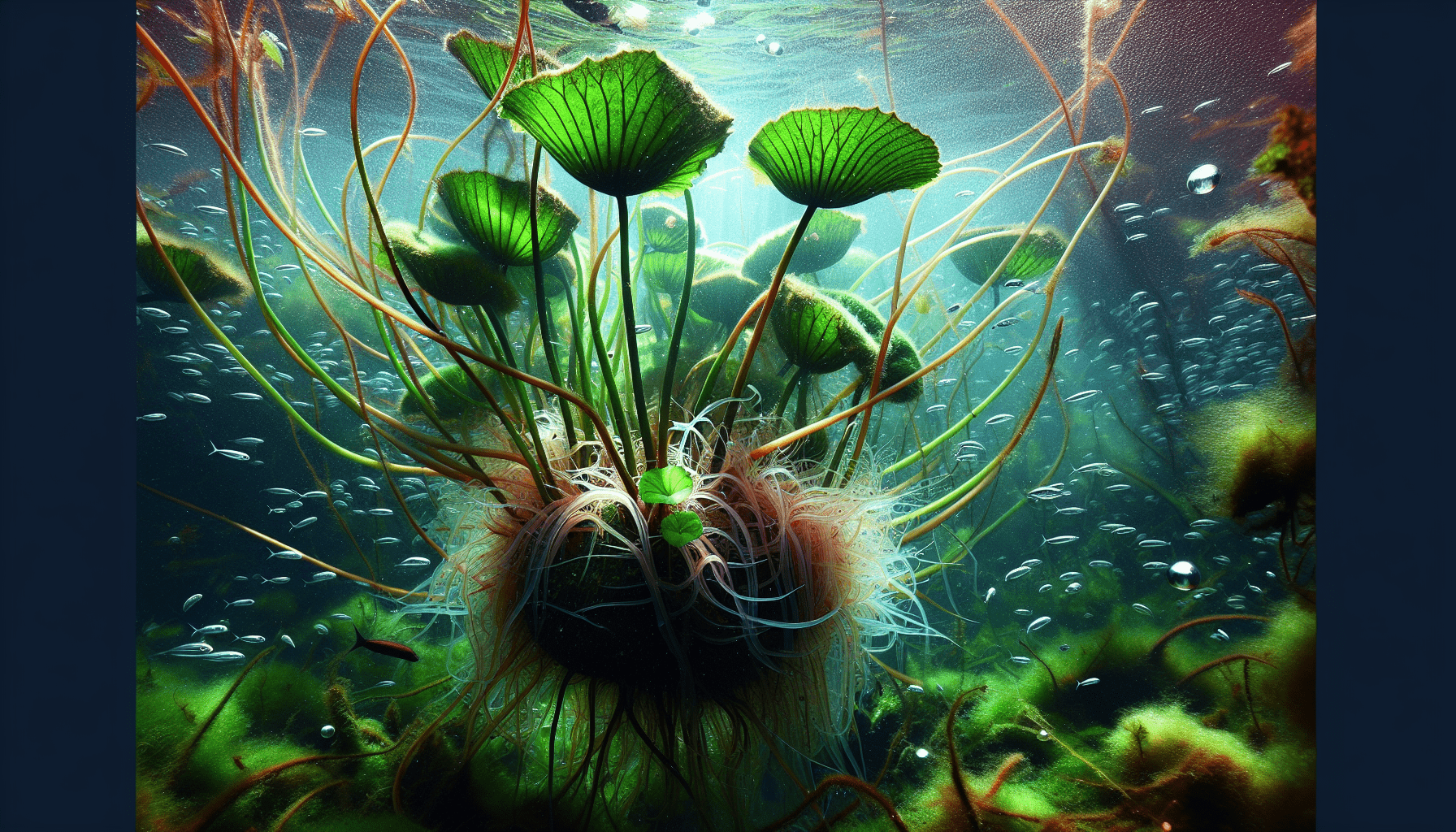In this scholarly exploration, the focus is on the lesser-known aquatic weed, Echinodorus Subalatus. With your intellectual curiosity piqued, you will engage with a comprehensive understanding of this enigmatic underwater plant. This piece will elucidate its origins, its unique characteristics, its life cycle, and its impacts on the surrounding aquatic ecosystem. Equipped with this knowledge you’ll not only fathom the idiosyncrasies of Echinodorus Subalatus, but also appreciate the intricate web of life that exists beneath the water’s surface.

Definition of Echinodorus Subalatus
Echinodorus Subalatus, a species of aquatic weed, belongs to the Alismataceae family. It hails from the plant genus Echinodorus, famously known for its aquatic and semi-aquatic plants. This species has built a reputation for its resilience and adaptive nature in diverse aquatic environments.
Scientific classification of weed
The scientific classification of Echinodorus Subalatus is as follows:
- Kingdom: Plantae
- Order: Alismatales
- Family: Alismataceae
- Genus: Echinodorus
- Species: Subalatus
Other common names
The common name of Echinodorus Subalatus is the Broadleaf Amazon Sword, attributed to its originating location in Southern America, specifically the Amazon Basin.
Physical characteristics
Echinodorus Subalatus is characterised by its broad leaves that resemble a sword-like shape, hence the term ‘Broadleaf Amazon Sword’. Its leaves possess a vibrant green hue and can grow up to approximately 20 centimetres in length. The plant has a resilient underground root system that firmly secures it in an aquatic substrate.
Habitat of Echinodorus Subalatus
Natural habitat
The natural habitat of Echinodorus Subalatus is predominantly in freshwater ecosystems. This species thrives in rivers, swamps, lakes, and slow-moving water bodies in the Amazon basin and other regions of South America.
Regions of growth
While native to South America, the adaptive nature of Echinodorus Subalatus has enabled it to naturalise and propagate in other parts of the world. This plant is familiar to aquatic environments in North America, Africa, and Asia.
Preferred environmental conditions
Echinodorus Subalatus prefers freshwater ecosystems with slow-moving water. It thrives in natural light but can survive in partially shaded areas. The plant grows optimally in water with a pH range of 6.5 to 7.5 and a temperature range of 22°C to 28°C.
Life Cycle of Echinodorus Subalatus
Growth stage
In its growth stage, Echinodorus Subalatus focuses on leaf production, sending out broad leaves from a central point. The leaves continue to grow, propagating towards the surface of the water.
Reproductive stage
The reproductive phase usually commences after the completion of the initial growth phase. This plant utilises sexual reproduction, with flowers emerging above the water surface. Cross-pollination facilitates fruit formation, containing the seeds.
Common diseases and pests
Echinodorus Subalatus is a robust species with a high disease resistance. However, it can occasionally be subjected to algae infestation, particularly in environments with excessive nutrients. It is also vulnerable to snails and other herbivorous pests that can feed on its broad leaves.

Nutritional Requirements of Echinodorus Subalatus
Preferred soil composition
Echinodorus Subalatus thrives in a soil rich in iron and other essential nutrients. It prefers a clayey, loamy substrate that supports its robust root system.
Water and sunlight requirements
This aquatic weed requires a moderate to high amount of light to perform photosynthesis effectively. However, it can adapt to lower light conditions if necessary. It also calls for a regular water change to maintain optimal nutrient concentrations.
Optimal temperature and pH levels
Echinodorus Subalatus grows best in a temperature range of 22°C to 28°C and prefers a slightly acidic to neutral pH range of 6.5 to 7.5.
Propagation Methods for Echinodorus Subalatus
Sexual propagation
The primary method of propagation for Echinodorus Subalatus is via sexual reproduction. The plant produces flowers that once cross-pollinated, generate fruits, which subsequently bear seeds.
Vegetative propagation
Echinodorus Subalatus can also propagate through vegetative means. Runners originating from a mother plant can independently establish a new plant.
Asexual propagation via debris or fragmentation
In some instances, fragmentation can also spur the growth of a new Echinodorus Subalatus plant, consequently expanding its spatial coverage.
Role of Echinodorus Subalatus in Ecosystem
Food source for marine animals
The Echinodorus Subalatus serves as a food source for a diversified range of aquatic creatures such as molluscs, crustaceans, and herbivorous fish.
Shelter for small fishes and amphibians
Its broad leaves offer a shield, creating a shelter, spawning ground and nursery habitat for small fishes and amphibians.
Its role in maintaining water quality
Through the process of photosynthesis, Echinodorus Subalatus aids in maintaining water quality by absorbing excess nutrients, which contributes to decreasing the conditions that favour algal blooms. By absorbing Carbon Dioxide and releasing Oxygen, it contributes significantly to the oxygen content of the water body.
Utilization of Echinodorus Subalatus
Use in aquascaping
Given its structural aesthetic and adaptive capabilities, Echinodorus Subalatus is popular for use in aquascaping in home aquariums and fish tanks. Its broad leaves provide a brilliant green backdrop, improving the landscape’s overall aesthetic appeal.
Role in traditional medicine
In some cultures, Echinodorus Subalatus has a foothold in traditional medicine practices. It is believed to possess beneficial properties used to treat various ailments and conditions.
Use as feed for certain aquatic animals
Echinodorus Subalatus serves as a food source in certain aquaculture practices. It provides nutrients to freshwater snails, crustaceans, and herbivorous fish species.
Management and Control of Echinodorus Subalatus
Mechanical methods of control
Mechanical control methods such as hand-pulling or underwater cutting can be employed to manage and control the growth of Echinodorus Subalatus, especially when it transforms into an invasive species.
Chemical methods of control
In certain scenarios, the application of specified aquatic herbicides can effectively control Echinodorus Subalatus. Nevertheless, thoughtful discretion is paramount given potential ecological implications.
Biological control methods
The introduction of herbivorous animals, such as certain fish or invertebrates, can aid in controlling the population of Echinodorus Subalatus in an ecosystem.
Impact of Echinodorus Subalatus on Human Activities
Effects on fishing activities
Increased proliferation of Echinodorus Subalatus can impede fishing activities, complicating navigation and access to fishing grounds, and interfering with fishing gear.
Implications for water transport
Thick mats of Echinodorus Subalatus can impede water transport, affecting the operations of smaller vessels in particular.
Impact on water treatment and supply systems
Echinodorus Subalatus can obstruct water treatment and supply systems, posing significant challenges in water management and provision for human use.
Research and Studies on Echinodorus Subalatus
Current scientific research
Currently, scientific research on Echinodorus Subalatus centers on understanding its physiological needs, ecological implications, and its potential uses. Genome sequencing and molecular studies are often employed to gain deep insight into this species.
Areas of future research
Future research may explore the plant’s potential medicinal use, its bioactive compounds, and sustainable methods to control its growth when it becomes invasive.
Implication of findings on policy and practices
Studies on Echinodorus Subalatus are crucial for informing policy decisions about its management, particularly in regions where it transforms into an invasive species. Moreover, understanding its important role in the ecosystem helps devise best practices for conserving biodiversity and maintaining water quality.